
|   |

|   |
Odissi International 2011: 2nd edition - Dr. Sunil Kothari e-mail: sunilkothari1933@gmail.com Photos: Arabinda Mahapatra January 8, 2012 Odissi International 2011 with its 2nd edition, started in 2010 by Shyamhari Chakra, Kedar Mishra and Ramhari Das with their personal voluntary contributions and later on supported by Indian Council for Cultural Relations (ICCR) and few patrons, and well wishers has generated tremendous enthusiasm amongst Indian and international community of Odissi dancers. Being journalists and critics, they have succeeded with their enthusiasm to foster such wonderful spirit. This festival preceded the 4th edition of International Odissi Dance Festival 2011 organized by Indian Performing Arts Promotion (IPAP), Washington DC, in collaboration with Govt. of India, Dept of Tourism, Govt. of Orissa, Kelucharan Mohapatra Odissi Research Centre, Indian Council for Cultural Relations (ICCR) and various other sponsors, and the event of Odissi staging for world record in Guinness Book. Like last year, I was fortunate to be invited this year.
Kedar Mishra spoke about how this international Odissi festival started last year and how this year the response has been overwhelming. To receive support from legendary dancers like Priyambada Mohanty Hejmadi, to whom credit goes for discovery of Odissi through her performance during Inter University Youth Festival held in Delhi in 1954, and others like Minati Mishra, Kum Kum Mohanty, Guru Banamali Maharana, Ritha Devi, speaks volumes for the festival's popularity. Priyambada Mohanty Hejmadi spoke warmly about beginnings of Odissi dance and what challenges it faces now. She emphasized the relevance of Odissi music and told the international gathering of young dancers why it is important to learn music and have rigorous sadhana (practice). She said that typical Odissi music has contributed a lot to the popularity of Odissi dance, though it is only of late that Odissi music is receiving recognition as an independent school of music on par with Hindustani and Carnatic music. Kum Kum Mohanty, another pioneer, reminisced how her Guru Kelucharan Mohapatra taught her and others dance and insisted that young dancers must pay attention to solo dance in its entirety. She considers herself fortunate to serve Odissi with her performances and researches and even today, she teaches and performs. Minati Mishra, another senior legendary dancer spoke about her long service at Utkal Sangeet Mahavidyalaya and with assistance of two other legendary gurus Pankaj Charan Das and Deba Prasad Das, how Odissi was established on a firm footing in Orissa. Guru Banamali Maharana, disciple of Guru Kelucharan Mohapatra, also emphasized the relevance of percussion music and need for a young generation of mardala/pakhavaj players. Ritha Devi, past 80, spoke glowingly about her total devotion to Pankaj Charan Das and blessings she had received to serve Odissi, performing his choreographic works, in particular Pancha Kanya, how Pankaj Charan Das had travelled with her in Mumbai and abroad spreading Odissi. I recalled seeing for the first time, Guru Deba Prasad Das demonstrating Odissi during All India Dance Seminar in April 1958. Kavi Chandra Kalicharan Patnaik had read a paper on Odissi dance and a galaxy of scholars, dancers, gurus, rasikas saw for the first time systematic exposition of Odissi, which opened the eyes of all present to this great legacy of Orissa. I paid tributes to Babulal Doshi, a Gujarati social worker, who had established Kala Vikash Kendra at Cuttack to train dancers in Odissi and where Guru Kelucharan Mohapatra taught for several years. I acknowledged gratitude to the legendary gurus, Kala Vikash Kendra and dancers, which helped me write my book on Odissi (1990). Today after 55 years, Odissi has spread globally and to see so many dancers coming to Bhubaneswar and perform Odissi indeed is a fantastic phenomenon. It will go down in history and the heart warming feeling of one family created by this festival is unparalleled. Pratap Das, Director IPAP, assured organizers of his full support. Ashok Tripathy, Secretary, Culture and Tourism, Govt of Orissa, promised all help and announced that this festival will continue regularly and the venue will shift from the small auditorium of Utkal Sangeet Mahavidyalaya to Rabindra Mandap. Kedar Mishra insisted that Utkal Sangeet Mahavidyalaya auditorium is the best as it is intimate and helps audiences to enjoy dance from close quarters. Ashok Kumar Tripathy then gave Ritha Devi, Pratap Das and me publications of Dept of Tourism including second revised and extended edition of Priyambada Mohanty Hejmadi and her daughter Ahalya Hejmadi Patnaik's Odissi book along with few CDs of dance, music and sculpture. The 2nd edition of Odissi International 2011 took place at Utkal Sangeet Mahavidyalaya's small but intimate and cozy auditorium after the formal inauguration in the presence of the legendary exponents and musicians mentioned. The five days (Dec 18 - 22) performance schedule was singlehandedly managed by Shyamhari Chakra with 150 and more dancers from within India and abroad from 12 countries. Minus volunteers and man power, the three stalwarts have proven that they can do wonders, when there is a will and also goodwill! 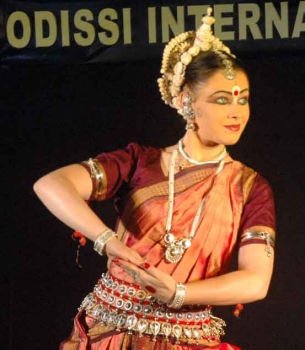 Brinda Rani (from Russia) 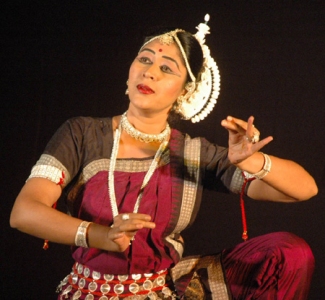 Indu Vijay (from Singapore) 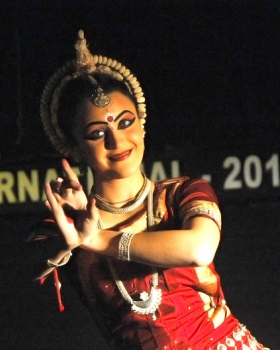 Kishori Das (from Germany) 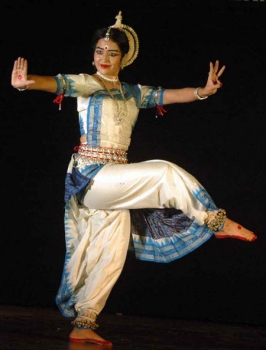 Maria (from Peru) Glancing through the list, I saw alphabetically the names of the participants as follows: I am mentioning a few names only. Brazil: Rie Kohers; France: Lawrence Le Banil Simon; Germany: Kishori Das; Israel: Yuval Cohen; Japan: Akane Hosino, Kazuko Yasunobu, Studio Odissi Takyo group, Yuk Noriko, Heruka, Miki, Sayo; Malaysia: Nritta Ganeshi Manoharan, Sandhya Manoj; Russia: Belchenko Natalia, Elena Kayazeva, Iakoleva Elena, Irina Komisavrova, Vitalina Lebach, Brinda Rani, Sevichenko Anastasia, Tassia Shpulnikova, Valeeva Olga, Group Odissi Jivan Nritya, Indian Cultural Centre, Embassy of India, Moscow; Singapore: Indu Vijay, Jyoti Unni; Sweden: Ulrika Larsen; UK: Natalie Raut; USA: a large contingent including Aditi Bandopadhyaya, Amanda Gregory, Arunima Roy, Divya Saha, Douglas Ridings, Durga Bor from Cornell University, Jamie Lynn Colley, Jyoti Raut, Ellora Das, Jiwan Pani Dance Company (a school of Odissi in name of renowned late Oriya poet and scholar Jiwan Pani being run at Raleigh in USA), Maissa Bertz-Zaill, Melissa Sproul Singh, Pallavi Das, Rasika Kumar, Sarvani Euheimo, Nagehally, Sibani Das, Sonali Mishra (Lara), Isabella Bue group USA, Guru Shraddha Dance Ensemble (Niharka Mohanty), Urvasi Dance Company (of Ratna Ray Evergreen College, near Seattle). I shall mention also few names from the schedule of dancers from within India to give an idea of the representation of dancers from other states besides Odisha. From Bengaluru came Maya Krishnamurty, Madhulita Mohapatra, Srajana Kaikini; Bihar: Sabita Mishra, Nayonika Roy, Manami Chatterjee; Chennai: Sikata Das; Kolkata: Argha Chatterjee, Kaustuvi Sarakar (she divides her time between Ohio and Kolkata), Ranjita Banerjee; New Delhi: Barkha Tanvir, Jyoti Srivastav, Prachi Hota, Rahul Vaishnavi; Mumbai: Aditi Mitra, Ankur Ballal (of Smitalaya run by Jhelum Paranjape), Siddhi Juvekar (Kaishiki) Sharoshi Mazumdar; UP: Kunjalata Mishra (from Vrindavan) and the largest contingent was from Odisha. Bhubaneswar: Preetisha Mohapatra (granddaughter of Kelucharan Mohapatra from Srjan), Aruna Mohanty, Pravat Kumar Swain, Madhusmita Mohanty of Odissi Dance Academy, Rahul Acharya, Bikash Kumar Nayak of Rudrakshya, Debayani Priyadarshini from Angul, Guru Gajendra Panda of Tridhara, Gayatri Chanda, Itishree Devi, Lingaraj Pradhan, Leena Mohanty and Leesa Mohanty (Bansi Bilas), Lipsa Mahapatra, Meera Das and her Gunjan institute from Cuttack, Sujata Mohapatra of Srjan, Rajashree Praharaj, Tulika Tripathy (disciple of Kum Kum Mohanty) and too many more to list them here. Besides, there was a special slot for Mardala Ensemble by Guru Sachidananda Das and troupe and also duet and group presentations. 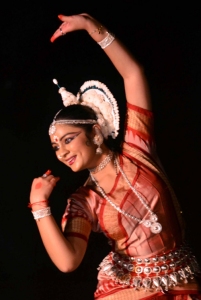 Nritta Ganeshi (from Malaysia) 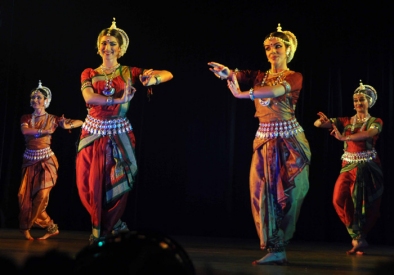 Russian group In its width and outreach, the festival was indeed unique. Not only that the details were given of what dance numbers the artists would perform acknowledging choreography by the guru, but also brief announcements were made introducing the young dancers. A festival on such a large scale, with such meticulous preparations both on the part of the organizers and participants is rare. Both in terms of nritta and abhinaya numbers, indicating the innumerable compositions by the legendary gurus and their disciples, the sumptuous fare was mind boggling. It also indicates the horizontal growth of art across not only within India but also abroad. Begun with only enthusiasm as their bank balance, the organizers indeed succeeded in uniting dancers to join hands voluntarily to perform on a common platform. I did not notice any one exceeding the allotted time limit nor insisting to dance before some particular artistes or making unreasonable demands. Also after the performance was over, quietly the dancer came and sat down in the auditorium to watch other artistes. That was a major gain for this generation of dancers. Seniors like Aruna Mohanty, Sujata Mohapatra, Yuva Puraskar awardees like Rahul Acharya and Mridusmita Mohanty performing without any ego before these young dancers from within India and abroad boosted up their morale. After their performance, the dancers were felicitated by senior dancers like Priyambada Mohanty, Minati Mishra, Kum Kum Mohanty, Aruna Mohanty, Sujata Mohapatra, Menaka Thakkar (Canada), Dr. Ratna Roy (Seattle), Ritha Devi from Pune, and occasionally I was also asked to felicitate them. 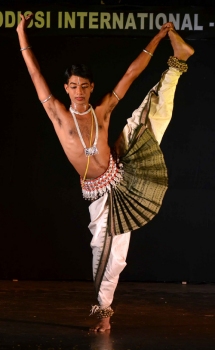 Rahul Acharya 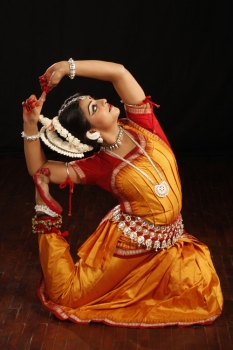 Pallavi Das (pic: Avinash Pasricha) Each evening featured chief guests from various fields and walks of life. Their presence encouraged young dancers. Thereby they also enlisted support of the leading lights of the dance world. On second day, the 19th December, the chief guests were Aruna Mohanty, Vice President of Odisha Sangeet Natak Akademi, Ratna Roy, Director, Urvasi Dance Company, USA, Gourhari Das, Executive Editor, Sambad, with its largest circulation among Oriya language newspapers, Khirod Patnaik, Secretary, Odisha Society of Performing Arts, Ratikant Mohapatra, Kelucharan Mohaptara's son and director of Srijan. Others who were associated in this capacity were Guru Durgacharan Ranbir, Durga Bor from USA, Ileana Citaristi, Odissi's Italian connection settled in Bhubaneswar, running her own institution Art Vision, Guru Bichitrananda Swain, Jyoti Raut from USA, Nilambar Rath; in short they succeeded in involving majority of people who matter. It also helped them watch the performances of young dancers. On the opening day I could see few performances. The festival opened with Shraoshree Mazumdar, a disciple of Nivedita Mukherjee, from Mumbai. She presented a pallavi in Rageshree which was executed with aplomb and confidence. The pleasure was watching 13 year old Preetisha Mohapatra, Kelubabu's granddaughter who presented Kirwani pallavi as choreographed by Kelubabu. She has the spark in her, and the blood speaks. She resembles her mother Sujata Mohapatra and performs with natural ease. There is no doubt that she will go places. With her parents Sujata and Ratikant's guidance, she is a lucky young dancer, promising to carry on Guru Kelucharan Mohapatra's legacy. Another dancer who drew my attention was Kum Kum Mohanty's Tulika Tripathy in abhinaya piece "Saja Kanja nayana" choreographed by Kum Kum. She should guard against exaggerated abhinaya. The inauguration ceremony had extended much beyond allotted time and the next session which was to start at 2.30pm to 5.30pm started much late and extended till late hours in the night. The 5.30pm till 8.30pm slot was the session mainly for dancers from abroad and the last session was for group choreography featuring Gunjan Dance Academy. 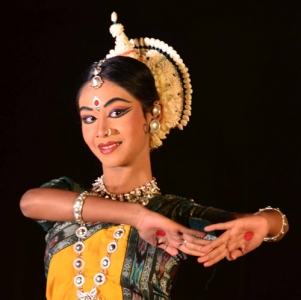 Preetisha Mohapatra 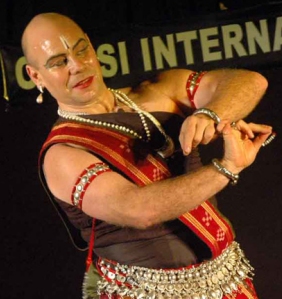 Yuval Cohen (from Israel) On November 13, on the last day of the 9th edition of Bhagyachandra National Dance Festival 2011 in Imphal, photographer Avinash Pasricha and I had a car accident hurting our necks and backs, and I was advised complete rest and physiotherapy. I was out of commission for more than a month, so I could attend the inaugural event and took rest for next day. On 20th December was my birthday and Shyamhari and Kedar Mishra brought me to the theatre and honoured me on stage. Their unalloyed affection for me moved me. I have never experienced so much affection in public domain and I am grateful to all of them and prayed to God to give me enough strength to continue to serve dance. Along with me the light wizard Jaidev was also honoured as his birthday also falls on 20th December. He has been such a source of strength to Odissi dancers having worked with stalwarts like Guru Kelucharan Mohapatra and senior dancers. I was also moved by Aruna Mohanty's performance on Krishna theme, which she had specially choreographed taking different songs and made into a garland of abhinaya. From Krishna's childhood to his youth, his indescribable beauty, weaving in Pankaj Charan Das' Madhurashtakam, Deba Prasad Das' Thai, engaging Oriya traditional song "Dekhi mu para asare prana sangini Bansidhar besa ku"... ah, what a delight it was to see her in her element. Registering subtle nuances, vatsalya bhava, then mugdha nayika's expressions, her face became a playground of varying emotions, captivating the audience. I had seen this number performed by her in Bangalore, but this particular one was very moving as she was completely immersed into it. Her choice of songs, episodes and appropriate abhinaya were a highlight of the evening. No wonder she received standing ovation. Young dancers rarely get an opportunity to witness such a well conceived choreographic work on Krishna theme weaving in several episodes briefly. I could catch up with Russian dancer's abhinaya pada of Gotipua dance tradition which Kelubabu has metamorphosed into an exquisite piece, "To lagi gopa danda mana re Kaliya suna"- O Krishna, on account of you I am unable to go and sell curd. It is my favourite song and brings back to me happiest memories of Guru Kelucharan Mohapatra's inimitable abhinaya. In Mumbai at C. J. Hall during Kal Ke Kalakar festival and lec-dem series for a decade from 1971 till 1980, Guruji used to perform it winning the hearts of audiences. I am not sure of the dancer's identity, but she performed with such 'mock anger' chiding Krishna that one was surprised how the Russian dancer captured the nuances so well. From London, one young Oriya dancer with a name which sounds like someone from abroad, Natalie Raut, also danced with complete involvement striking sculpturesque poses in nritta, a pallavi. With her natural beauty and youth she drew attention of senior dancers. Her mother told me that it was through Facebook that she had got in touch with Shyamhari and had come to know of this unique festival. And Natalie was happy to have got an opportunity to perform. A festival which ran for five days featuring so many dancers indeed was a treat. Even though I could not attend it daily, I met dancers who filled me up on the news. When I cast a glance at the various compositions, I am struck by the sheer diversity of choreographic works and also realize how Bhubaneswar Mishra, the legendary Oriya violinist, a disciple of Dwaram Venkateswar, and Guru Kelucharan Mohapatra composed some evergreen pallavis like shankarabharanam and arabhi pallavi which continue to cast a spell on us the moment we listen to it. For forty years, I have been drunk on that music watching dancers performing these two pallavis. Other favourite pallavis were Basant, Kirwani, Kalavati Mohana, Hamsadhwani, Khamaj, Rageshree and Bakulabharanam. They gave dancers opportunity to execute nritta with innumerable sculptureseque poses. Thematic content were explored by compositions of Banamali, Upendra Bhanj, Kishore Chandrananda Champu and Ashtapadis of Gita Govinda. Also prayers devoted to Ganesh, Lord Shiva, and specially choreographed solo number like Karna for Lingaraj Pradhan, scripted by Kedar Mishra. Choreographic works of Guru Pankaj Charan Das were few, more popular were of Guru Kelucharan Mohapatra, some arresting Sabdaswarapata of Guru Deba Prasad Das, Guru Durgacharan Ranbir's group work, solo by Rahul Acharya, and others. The foreign component dwelt upon abhinaya in compositions like Mohane Delichahni, Gotipua song 'To Lagi', Guru Gangadhar Pradhan's Divya Kundala, homage to Lord Shiva, performed by Sweden's Ulrika Larsen, one rare number was Konarak Kanti choreographed by Surendra Nath Jena by Belchenko Natalia from Russia. The unqualified success of the festival raises some pertinent issues. Where live music was not available, of course the dancers had to depend upon recorded music using CDs. It has its own context, the difference with live music overshadowing recorded music. Also the question of quantity against quality crops up. Not that organizers are not aware of the limitations. But they want the spirit to continue and in coming years work out strategies to address these issues in order to make mounting of such a festival a meaningful activity. At present the excitement and involvement are so intense that the Odissi dancers' community wishes to meet, be in intimate company, watch what others offer and learn from that exposure what best they should do. In 2010, Shyamhari Chakra had edited Odissi Annual which laid emphasis on various aspects of Odissi dance which both foreign and Indian exponents wanted to be aired. I was told that this year also, the Annual was under print. It would be interesting if it would cover relevant issues and not fall into 'popular rut' of ten best Odissi exponents. Such categorizations are mindless and useless. In final analysis the best survive and such steps do not help any dancer. I would suggest keeping away from such short cuts. Instead detailed interviews with senior dancers, their experiences would provide valuable guidelines and help the movement positively. Perhaps someone like Dr Ratna Roy should take a lead and work out some ways to make video recordings accessible for studies. Such volume of compositions indeed is a precious legacy. The width and scope of the festival justifies it.  Dr. Sunil Kothari is dance historian, scholar, author and a renowned dance critic. He is Vice President of World Dance Alliance Asia Pacific India chapter, based in New Delhi. He is honored by the President of India with Padma Shri, Sangeet Natak Akademi award and Senior Critic Award from Dance Critics Association, NYC. He is a regular contributor to www.narthaki.com and is a contributing editor of Nartanam for the past 11 years. Post your comments Pl provide your name and email id along with your comment. All appropriate comments posted with name and email id in the blog will also be featured in the site. |